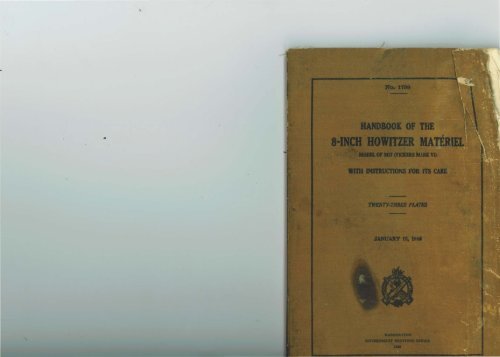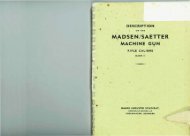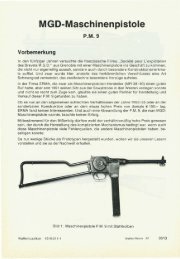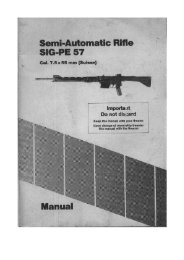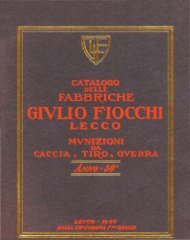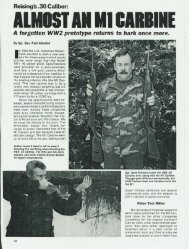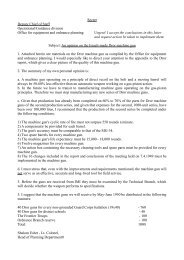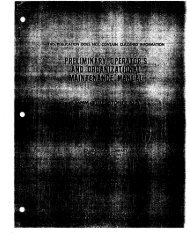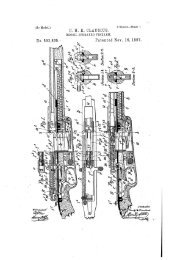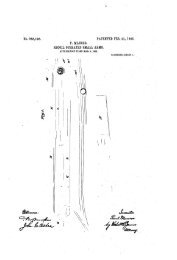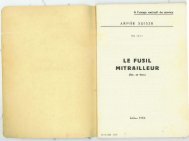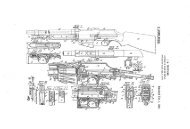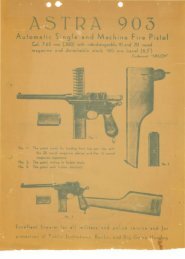8 inc Howitzer manual.pdf - Replica Plans and Blueprints
8 inc Howitzer manual.pdf - Replica Plans and Blueprints
8 inc Howitzer manual.pdf - Replica Plans and Blueprints
Create successful ePaper yourself
Turn your PDF publications into a flip-book with our unique Google optimized e-Paper software.
9<br />
plunger on the left side, which serves liB a reader for the recoil scale<br />
on the cradle. A steel stop plate is attached to the front face of the<br />
guides by four screwed rivets.<br />
The breech ring is prepared for the reception of the breech mechanism<br />
<strong>and</strong> provided on the underside with a lug for •he attachment of the<br />
body of the hydraulic buffer <strong>and</strong> recuperator of the carriage. Securing<br />
screws are provided in the breech face to prevent the breech ring from<br />
turning when in position.<br />
Right <strong>and</strong> left gun-metal dust covers with securing screws connect<br />
the front <strong>and</strong> rear guides.<br />
The chamber is cylindrical, coned at the entrance <strong>and</strong> reduced in<br />
diameter at the front end.<br />
· A plane for a clinometer is prepared on the right upper side of the<br />
breech ring.<br />
Axis lines are cut on the upper side <strong>and</strong> on the horizontal axis at<br />
the breech <strong>and</strong> muzzle ends. Fine horizontal <strong>and</strong> vertical axis lines<br />
are also cut on the· breech <strong>and</strong> muzzle faces.<br />
The actual weight of the howitzer (without breech mechanism) is<br />
engraved on top of the breech ring, <strong>and</strong> a line, denoting center of<br />
gravity (without mechanism), is cut transversely on the upper side<br />
of the jacket immediately in front of the rear guide ring.<br />
The t ype, mark, register number, manufacturer's initials, <strong>and</strong> year<br />
of manufacture are engraved on the upper portion of the breech face.<br />
BREECH MECHANISM.<br />
(Plato II <strong>and</strong> IIA.)<br />
'The breechblock is worked by means of an operating lever on the<br />
right side of the breech. On pulling the lever to the rear the breechblock<br />
is automatically unlocked <strong>and</strong> swung into the loading position.<br />
After loading, one thrust on the same lever inserts the breechblock<br />
<strong>and</strong> turns it into the locked position.<br />
The breechblock is of the interrupted screw type. It is divided<br />
circumferentially into 12 equal parts, 4 of which are plain <strong>and</strong> the<br />
remaining 8 screw-threaded, thus giving a two-thirds bearing surface<br />
to the breechblock in the locked position. The threaded sectors<br />
are of different diameters, the breech recess of the howitzer having<br />
complementary threaded sectors to receive them. The interruptions<br />
in the howitzer are arranged to accommodate the sectors of the block<br />
of largest diameter ; thus, when the block is unlocked, these sectors<br />
pass into the interruptions <strong>and</strong> tho sectors smaller in diameter unlock<br />
into the spaces left vacant by those of the larger diameter.
13<br />
die of ilie fu·ing block. Unscrew the firing-medmn:ism block, slide the<br />
used primer out of the slot in the primer seat plug, insert n.new primer,<br />
<strong>and</strong> after the breech :is closed screw the block into the firing-mechanism<br />
housing. The fuing-mechn.nism h<strong>and</strong>le :is automatically locked by the<br />
safety latch when the h<strong>and</strong>le is rotated to its home position.<br />
The firing-mechanism block is interchangeable with the firingmechanism<br />
block used on the following gnns:<br />
155 mm. howitzer, model of 1918 (Schneider).<br />
155 mm. howitzer, model of 1917 (Bethlehem).<br />
155 mm. gm1, model of 1918 (Filloux).<br />
240 mm. howitzer, model of 1918 (Schneider).<br />
TO REMOVE BREECH MECHA.NISM.<br />
Before removing the mechanism, the breechblock must be opened<br />
<strong>and</strong> swnng into the loading position.<br />
OBTURATOR.<br />
Unscrew firing mechanism block from the firing mechanism housing.<br />
RemO\·c securing pin from the ret!:t:ining ring <strong>and</strong> wiilidraw the safety<br />
plunger housing. Unscrew the firing mechanism housing <strong>and</strong> remove<br />
obturator spring. Wiilidraw obturator spindle, pad, <strong>and</strong> rings as a<br />
unit from the front end of the breechblock.<br />
BREECHBLOCK.<br />
Insert a screw driver in slot of securing pin of the retaining plate,<br />
press in the pin <strong>and</strong> partially reYolve it by means of the screw driver<br />
tmtil the indicating l!>l-Tow on the pin corresponds with the middle of<br />
the word ''dismantle" on the breechblock, then 11ithdraw the breechblock<br />
from the front of the carrier.<br />
ROLLER.<br />
Remove the seeming pin <strong>and</strong> roller axis pin, <strong>and</strong> withdraw the<br />
roller.<br />
BREECH JIIECHAN!SM LEVER.<br />
Remove the securing pin <strong>and</strong> nut from the crartk shaft, <strong>and</strong> withdraw<br />
the breech mechanism lever.<br />
BREECH OPERATING LEVER BEARING, CRANl{ SHAFT, AND CROSSHEAD.<br />
Remove the securing pin <strong>and</strong> nut of the lever beruing seeming<br />
screw, <strong>and</strong> withdraw the securing screw. Withdraw the bearing <strong>and</strong><br />
crank shaft from the canier; at the same time, fmm inside the carrier,<br />
remove the crosshead from the inner end of the crank shaft.
24<br />
the hydraulic recoil cylinder <strong>and</strong> recuperator. The front end is closed<br />
by a cap to which are attached the piston rods of the recoil cylinder<br />
<strong>and</strong> of the recuperator. The cap is fitted with a shutter which enables<br />
the pressure to be tested without disconnecting gears or removing the<br />
cap. Brackets are fitted to the cradle in which are formed bearings<br />
for the quick loading <strong>and</strong> the variable recoil gears. Leather pads<br />
<strong>inc</strong>losed by a brass casing are fitted to the front of the cradle to act as a<br />
stop to the howitzer in retuming to battery. The cradle projects some<br />
distance beyond the breech of the howitzer to form a suppo1t for the<br />
latter in the recoil position. This projection is prepared on the underside<br />
to receive the traveling lock <strong>and</strong> on top to receive the loading tray.<br />
A spring pointer attached to the front guide ring of the howitzer on<br />
the left side indicates the correct amount of recoil according to the<br />
elevation at which the howitzer is fired.<br />
QUICK- LOADING GEAR.<br />
(Plate XII.)<br />
This gear is provided to unlock the cradle from the elevating arc,<br />
<strong>and</strong> thus allow the howitzer to be brought rapidly to the loading angle<br />
(7° 30' elevation) after firing, <strong>and</strong> vice versa. •<br />
The gear consists of a cross spindle supported in bearings of the underside<br />
of the cradle, to the right end of which is pinned the front end of<br />
the actuating lever, which is suppcrted in a bracket on the right side<br />
of the cradle. The actuating lever has a cranked extension at its front<br />
end, to which is pinned the rear end of a connecting rod. The latter<br />
has pinned to it at its front end a spring plunger, which, when the<br />
howitzer is in loading position, engages in a recess in a bracket on the<br />
top carriage <strong>and</strong> so holds the cradle <strong>and</strong> howitzer ready for loading.<br />
A spring buffer is fitted above this plunger to cushion the shock on the<br />
gear when coming into loading position. To the left end of the cross<br />
spindle is attached a short lever, to the upper end of which is pinned a<br />
spring plunger, which, when the howitzer is in firing position, engages<br />
in a recess in the elevating arc <strong>and</strong> so locks the cradle to the arc. There<br />
is also attached to the elevating arc an emergency clamp <strong>and</strong> stop,<br />
which, when in place, will not permit the use of quick-loading gear .<br />
.Action.-1'he howitzer, having been fired, the actuating lever is<br />
raised. This revolves the cross _spindle <strong>and</strong> lever, withdrawing the<br />
plunger from the elevating arc, compressing the spring, <strong>and</strong> unlocking<br />
the cradle. The actuating lever then comes to the end of its slot, <strong>and</strong><br />
continuing to lift on it depresses the howitzer to the loading position,<br />
at which point the forward plunger is forced into its recess in the bracket<br />
on the top carriage of the action of its spring.
72283·-ls. (To lace page 25.)<br />
A. c,.-acJ le.<br />
B Rear closing plug.<br />
C Adjuat.able valve _<br />
o cov11ter rPcoi/ but'rer<br />
E Nut" secur1ng f'e·coilvalve.<br />
F washer do.<br />
A liqu1d cylmdar.<br />
B Packed Piston.<br />
cRam .<br />
o ThrottJe Valve.<br />
E Th1<br />
F Stt<br />
G l..<br />
H Gla<br />
25<br />
After loading, the actuating lever is pressed downward, which withdraws<br />
the forward plunger, elevates the cradle <strong>and</strong> howitzer until the<br />
rear plunger, which slides along the elevating arc, comes opposite its<br />
recess in the htter into which it engages under the action of its spring,<br />
t.hereby locking the arc <strong>and</strong> cradle together.<br />
TRAYELIXG LOCK.<br />
(Plate \'Ill.)<br />
A steel channel-shaped bar has one end pivoted to the top of the<br />
right clamp of the traiL On top of the bar are two double lugs, through<br />
which it is pinned to the cradle for traveling purposes. The other end<br />
of the bar is shaped to fit into a bracket on the left flask, to which it is<br />
secured by a pin, which, when not in use, is suspended on the right<br />
side of the bar by a socket <strong>and</strong> hook.<br />
The traversing gear must be placed at zero before connecting the<br />
bar to the cradle. When not in use the bar is housed in a bracket on<br />
the top of the right flask of the trail.<br />
The bar is made removable in order to give clearance to the h<strong>and</strong>le<br />
of the loading tray when loading.<br />
HYDRAULIC RECOIL CYLINDER.<br />
(Plate Xill.)<br />
The recoil cylinder <strong>and</strong> the recuperator cylinders are contained in<br />
a steel block forming a recuperator body which fits inside the cradle<br />
<strong>and</strong> is provided with a guide on each side to fit in the guideways on the<br />
cradle. The body is connected at its rear end to the lug of the howitzer,<br />
<strong>and</strong> thus recoils with it while the piston rod of the recoil cylinder <strong>and</strong><br />
the rods of the recuperator are attached to the cradle cap. Five parallel<br />
openings are bored through the body, a center one to receive the<br />
recoil cylinder, two outside lower ones for the recuperator liquid cylinders,<br />
<strong>and</strong> two upper ones for the air cylinders.<br />
The recoil cylinder has cut in its interior surface two spiral grooves<br />
to rotate the recoil valve dw-ing recoil. The front end is closed by a<br />
8teel stuffing box, which is screwed into it against steel <strong>and</strong> leather<br />
\Yashers to make a tight joint. The stuffing box contains an L leather,<br />
which is held in position by a hollow gl<strong>and</strong> in which is placed the hemp<br />
packing ring. In front of this is placed a sleeve, against the flange of<br />
which bears a helical spring, the whole being kept in position by a<br />
cap which screws onto the stu!Iing box <strong>and</strong> bears against the spring.<br />
The stu!Iing box <strong>and</strong> cap are kept from unscrewing by locking plates.<br />
The rear end is closed by a steel plug forming a counter-recoil buffer<br />
which is screwed in against a leather washer to make a tight joint ana
27<br />
when elevating the howitzer, the actuating rod pulls upon the short<br />
lever, rotating the cross spindle, bevel segments, piston rod, <strong>and</strong> piston,<br />
thereby decreasing the orifice between the ports in the piston <strong>and</strong> the<br />
recoil valve, which is held fast by i ts keys <strong>and</strong> grooves in the cylinder.<br />
This <strong>inc</strong>reases the resistance set up in the recoil cylinder dming recoil,<br />
thereby shortening the recoil of the howitzer. The recoil varies from<br />
60 <strong>inc</strong>hes, howitzer horizontal, to 24 <strong>inc</strong>hes at 50° elevation, or 0.72<br />
<strong>inc</strong>h per degree of elevation.<br />
UECtJPERATOR.<br />
(Plate XIU.)<br />
The recuperator is of the hyclropneumatic pr<strong>inc</strong>iple <strong>and</strong> consists of<br />
two liquid cylinders in which work rams, <strong>and</strong> two air cylinders which<br />
contain both liquid <strong>and</strong> compressed air. The air cylinders are connected<br />
at their rear ends by an equalizing passage, <strong>and</strong> are also connected<br />
to the front end of the liquid cylinders by an annular recess<br />
around the latter, along which the liquid passes on recoil <strong>and</strong> counterrecoil.<br />
The liquid cylinders are closed at the rear end by perforated caps<br />
which are held by pins. The perforations allow any liquid which may<br />
get by the piston to get clear, otherwise the howitzer wo uld not return<br />
fully to firing position after recoil. They also prevent a vacuum forming<br />
in the rear of the recuperator ram.<br />
The front ends are closed by stuffing boxes, packing <strong>and</strong> caps in<br />
much the same manner as the recoil cylinder. Internally near its<br />
front end, each cylinder is reduced in diameter to form a seat for a<br />
throttle valve, which fits loosely around the piston rod <strong>and</strong> is kept to<br />
its seat by a helical spring, one end of which bears against the valve <strong>and</strong><br />
the other end against the inner face of the stuffing box.<br />
The valves are provided with a coned bead to fit tightly on their<br />
seat. Holes are bored through the head to allow liquid to pass back<br />
into the cylinders after recoil.<br />
The recuperator piston rods are of steel ; their front ends are seemed<br />
by a screwed sleeve inside <strong>and</strong> a nut ou tside to the cradle cap, while<br />
their inner ends are provided with a packed piston. The packing consists<br />
of two U-shaped leathers properly h eld by supporting rings <strong>and</strong><br />
secured by a nut, also a ring of h emp packing, which is kept tightly<br />
against the piston proper by a helical spring h eld by a nut.<br />
The piston rods are hollow; <strong>and</strong> the front end of each is prepared to<br />
take an adapter to which the pipe fro m the charging cup is connected<br />
when filling. A small side hole at the rear connects the interior of the<br />
rod with the liquid cylinders. When the adapter is not in use, the<br />
opening at the front is closed by a plug.
o·<br />
be<br />
ge<br />
hE<br />
ar<br />
ar<br />
ar<br />
p!<br />
or<br />
tl:<br />
rr<br />
t2<br />
el<br />
h<br />
c<br />
sJ<br />
p<br />
1<br />
g<br />
t<br />
r<br />
1:<br />
43<br />
head prism holder (Y), upon which the elevation segment (WS) is cut,<br />
is accomplished by the elevation worm (El ), <strong>and</strong> the length of travel is<br />
controlled by seven brass stop rings (R2). Each ring has a small tongue,<br />
the edge of which engages at each revolution of the elevation worm<br />
(E1) with the tongue on the adjacent ring. Each Ting is thus engaged<br />
in its turn until si .. 'C revolutions have been made, when the tongues<br />
are all in contact. <strong>and</strong> no further movement can be made in that<br />
direction.<br />
The prism shield (S1) is held within the rotating head (RH) by the<br />
prism shield retaining piece (3A), which is in turn secured by two<br />
prism shield retaining piece screws (2A).<br />
The prism holder cover (02) scTews into its threaded seat located<br />
in the right side of the rotating head prism holder (Y) <strong>and</strong> is locked<br />
in position by the prism holder cover screw (03).<br />
The rotating head cover (Cl) screws into its threaded seat located in<br />
the right side of the rotating head (RH) <strong>and</strong> is held in place by the<br />
rotating head cover screw (S7). The exterior of the rotating head cover<br />
(Cl) has two small holes for teat >aench, <strong>and</strong> engravings "Field 10° "<br />
<strong>and</strong> "Power 4" are located on the exterior surface.<br />
The elevation index support (G2) screws into its threaded seat<br />
located in the left side of the rotating head prism holder (Y), <strong>and</strong> is<br />
secured in place by the elevation index support screw (G7). The<br />
small holes in the exterior surface allow the use of a teat wrench, to<br />
enable the elevation index support (G2) to be screwed in place. The<br />
support retaining ring (G4) retains the elevation index support with<br />
rotating head prism holder within the rotating head <strong>and</strong> is locked in<br />
position by the supporting ring screw (G5).<br />
The elevation index (G6) is held upon the elevation index support<br />
(G2) by the two elevation index retaining screws (GS). The arrow<br />
engraved upon the German-silver piece which is dovetailed in the<br />
elevation index (G6) co<strong>inc</strong>ides with the graduations of the scale (G3)<br />
engraved upon the real' face of the rotating head (RH).<br />
ELEVATION DEVICE.<br />
The elevation device consists pr<strong>inc</strong>ipally of the elevation segment<br />
(WS), elevation worm (El), elevation worm ball cap <strong>and</strong> socket (1B<br />
<strong>and</strong> 2B), elevation worm plunger spring <strong>and</strong> plug (S3 <strong>and</strong> B2), elevation<br />
micrometer (R1), seven stop rings (R2), <strong>and</strong> elevation index<br />
(G6).<br />
The elevation segment (WS) is hob bed into the rotating head prism<br />
holder (Y) <strong>and</strong> meshes with the elevation worm (E1).<br />
The elevation worm (E1) is mounted in the back of the rotating<br />
head (RH) in a ball <strong>and</strong> socket bearing (2B ), which in conjunction with
49<br />
elevating gear of the carriage. Set site clinometer <strong>and</strong> range drum<br />
at zero. The bubble of the Rite clinometer should now be in the<br />
center of its run; if it is not, adjust as follows:<br />
Adjustment.-Bring the bubble of the site clinometer to the center<br />
of its run by working the milled head. Slacken the screw seeming<br />
the indicator of the mil scale <strong>and</strong> the nut securing the micrometer<br />
scales shift indicator <strong>and</strong> micrometer scales to zero <strong>and</strong> reclamp.<br />
4. To VERIFY PARALLELISU OF Lh'I"ES OF SIGHT A..'\'D AXIS OF BORE.<br />
The sights are correctly adjusted when, at zero elevation <strong>and</strong> deflection,<br />
the lines of sight are parallel to the axis of the bore.<br />
When the carriage is placed with wheels on a level platform, the<br />
howitzer with axis of bore horizontal, <strong>and</strong> the sights at zero elevation<br />
<strong>and</strong> deflection, the points in which the lines of sight <strong>and</strong> the axis of<br />
the bore prolonged pierce a distant plane perpendicular to the latter<br />
should be located with refereuce to each other as indicated on Plate<br />
XVIII.<br />
A target made according to the dimensions on Plate XVIII should<br />
be placed in a vertical position perpendicular to the line of sight at a<br />
distance of not less than 100 yards from the howitzer, <strong>and</strong> at such a<br />
height that the point B is at the same height as the axis of the bore of<br />
the howitzer. The verticality of the target should be assured by a<br />
plumb line attached at X <strong>and</strong> co<strong>inc</strong>iding with the vertical line<br />
through B .<br />
The carriage should be rested on carefully leveled solid supports;<br />
the howitzer should then be directed so that the axis of the bore, prolonged,<br />
pierces the target at the proper point. The lines of sight of<br />
the open <strong>and</strong> panoramic sights, if adjustment is true, should pierce<br />
the target in the points marked S<strong>and</strong> D, respectively.<br />
In order to train the bore of the howitzer accw·ately on B, secure two<br />
threads or hairs at the muzzle, fastening them perpendicular to each<br />
other with the point of intersect-ion co<strong>inc</strong>ident with the axis of the<br />
bore <strong>and</strong> sight through the axial vent of the breech mechanism.<br />
In the field, where from lack of time or proper facilities the method<br />
just given can not be followed, the adjustment of the sights may be<br />
verified by bringing the lines of sight at zero elevation <strong>and</strong> dellection<br />
to bear upon some sharply defined point of a distant object. At such<br />
a range (for instance, 2,000 yards or more) the parallax may be neglected,<br />
<strong>and</strong> if the sights are correctly adjusted the lines of sight <strong>and</strong> the<br />
prolongation of the axis of the bore will sensibly pass through the<br />
selected aiming point.
57<br />
ASSEMBUNG PLATFORM.<br />
(Plate XXII.)<br />
The front platform :\. may now be placed into position on tl.e side<br />
beams with its fomard end against the steel angles Q (fig. 17), the<br />
angles Ron the platform registering it laterally.<br />
FILLING IN -L'ID LEVELLlXG TJJE GROUND.<br />
Ram in the earth where required to Dl!l.ke flush with the grounrl<br />
level, taking care to leave the ground cut away to clear breech end oi<br />
gun at full recoil.<br />
A.<br />
f'LAN BHOWIHCi CARRIAGE IN CENTRAL X)StTION ON<br />
FlRING PL.ATFORIII .<br />
FIG. 18.<br />
ASSEMBUNG CABRIAGE ON BEAMS.<br />
Wheel the carriage into position on the beams mth the carriage<br />
wheels outside the angle guides U on the front platform A. Lower the .<br />
rear end so that the curved rib V on the thrust bracket fits into the<br />
channel recess Win the top rear beam, then p lace the pin X in the trail<br />
into one of the holes Y in the rear beam to suit required position of<br />
traverse.


